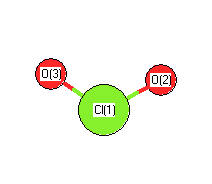Vibrational Frequencies calculated at B2PLYP=FULLultrafine/TZVP
| Mode Number |
Symmetry |
Frequency
(cm-1) |
Scaled Frequency
(cm-1) |
IR Intensities
(km mol-1) |
Raman Act
(Å4/u) |
Dep P |
Dep U |
|---|
| 1 |
A1 |
868 |
868 |
7.77 |
3193546.00 |
0.33 |
0.50 |
| 2 |
A1 |
399 |
399 |
19.93 |
2549.17 |
0.32 |
0.48 |
| 3 |
B2 |
1011 |
1011 |
1743.46 |
13790.65 |
0.75 |
0.86 |
Unscaled Zero Point Vibrational Energy (zpe) 1138.4 cm
-1
Scaled (by 1) Zero Point Vibrational Energy (zpe) 1138.4 cm
-1
See section
III.C.1 List or set vibrational scaling factors
to change the scale factors used here.
See section
III.C.2
Calculate a vibrational scaling factor for a given set of molecules
to determine the least squares best scaling factor.
